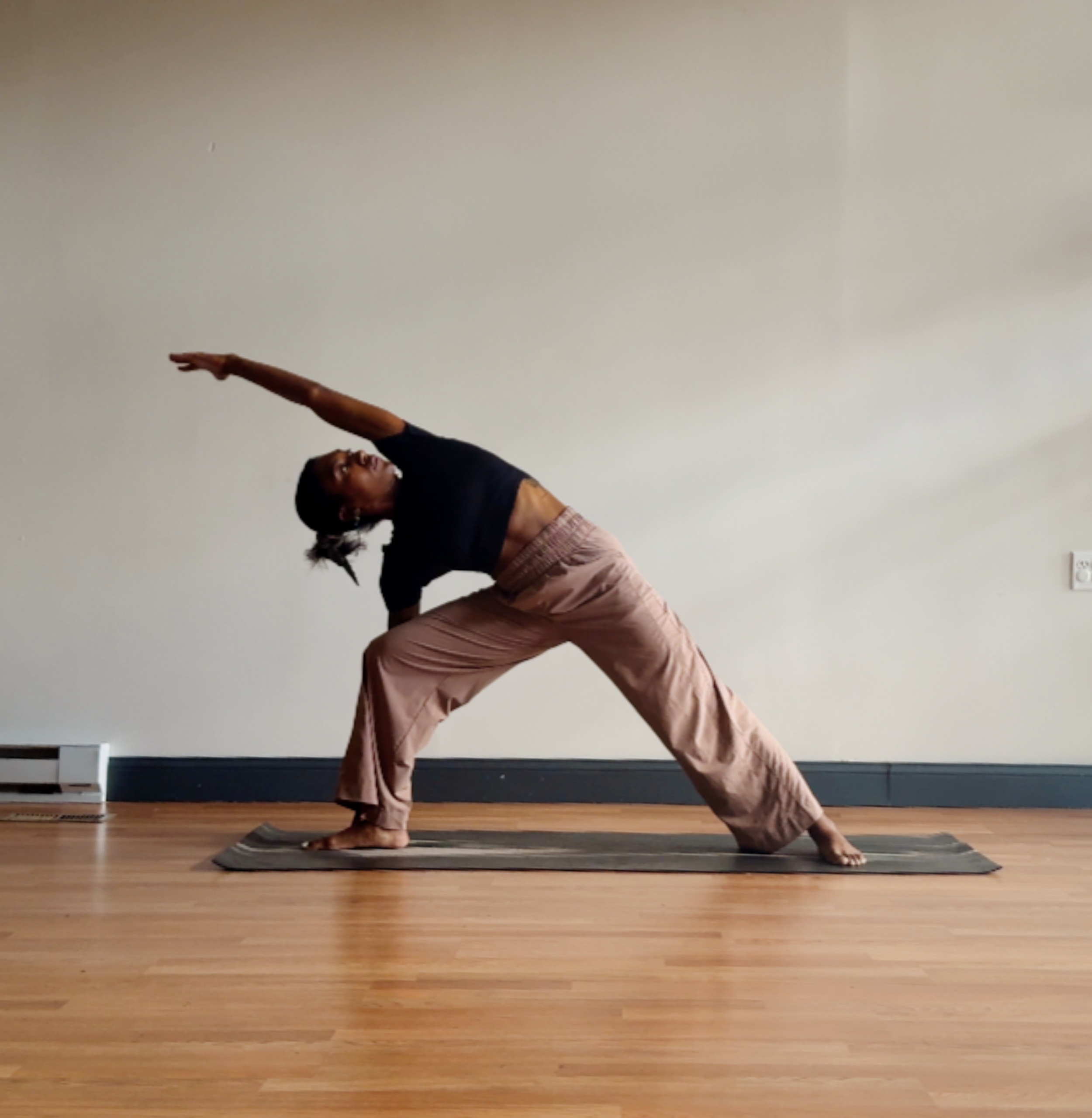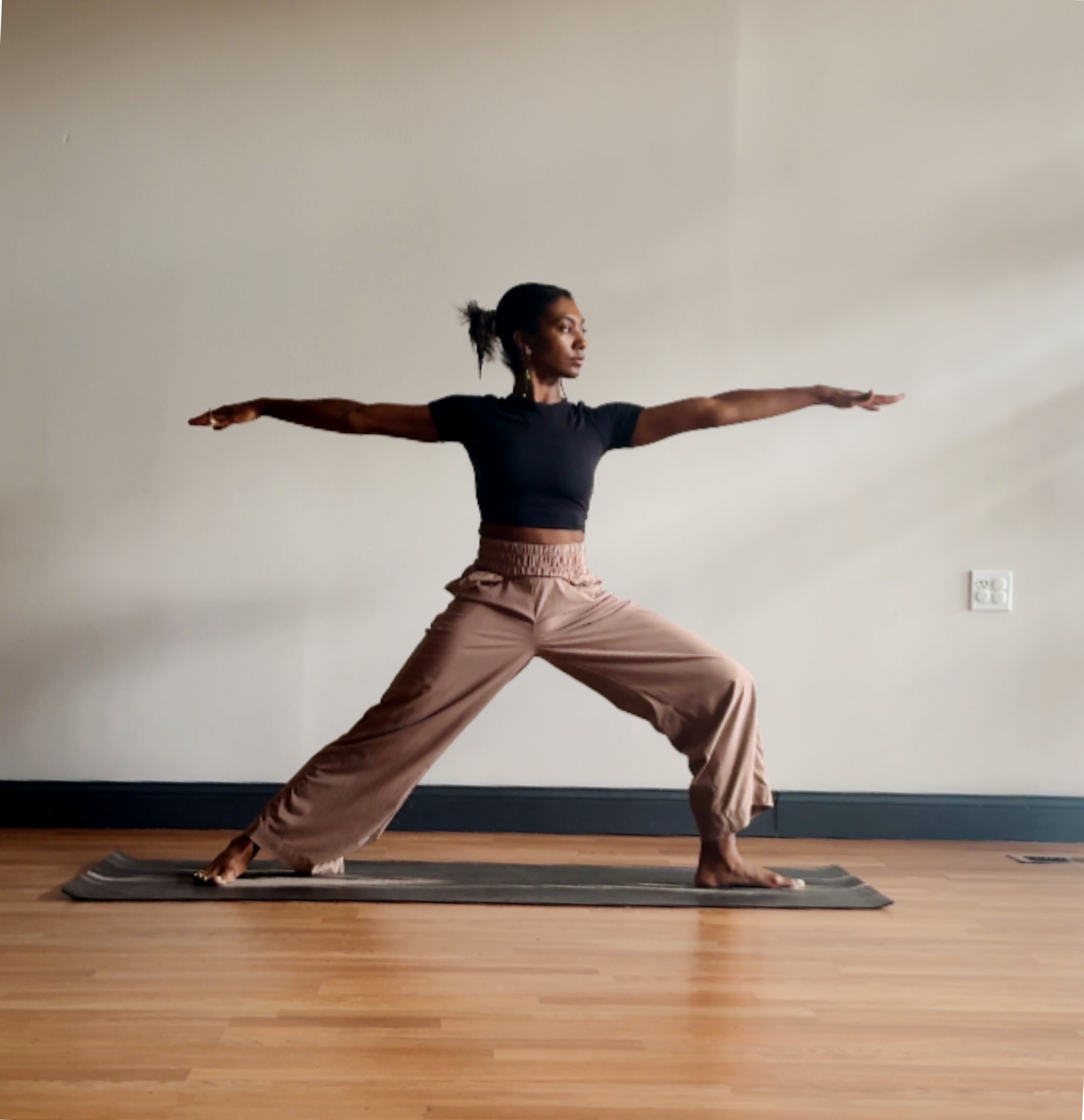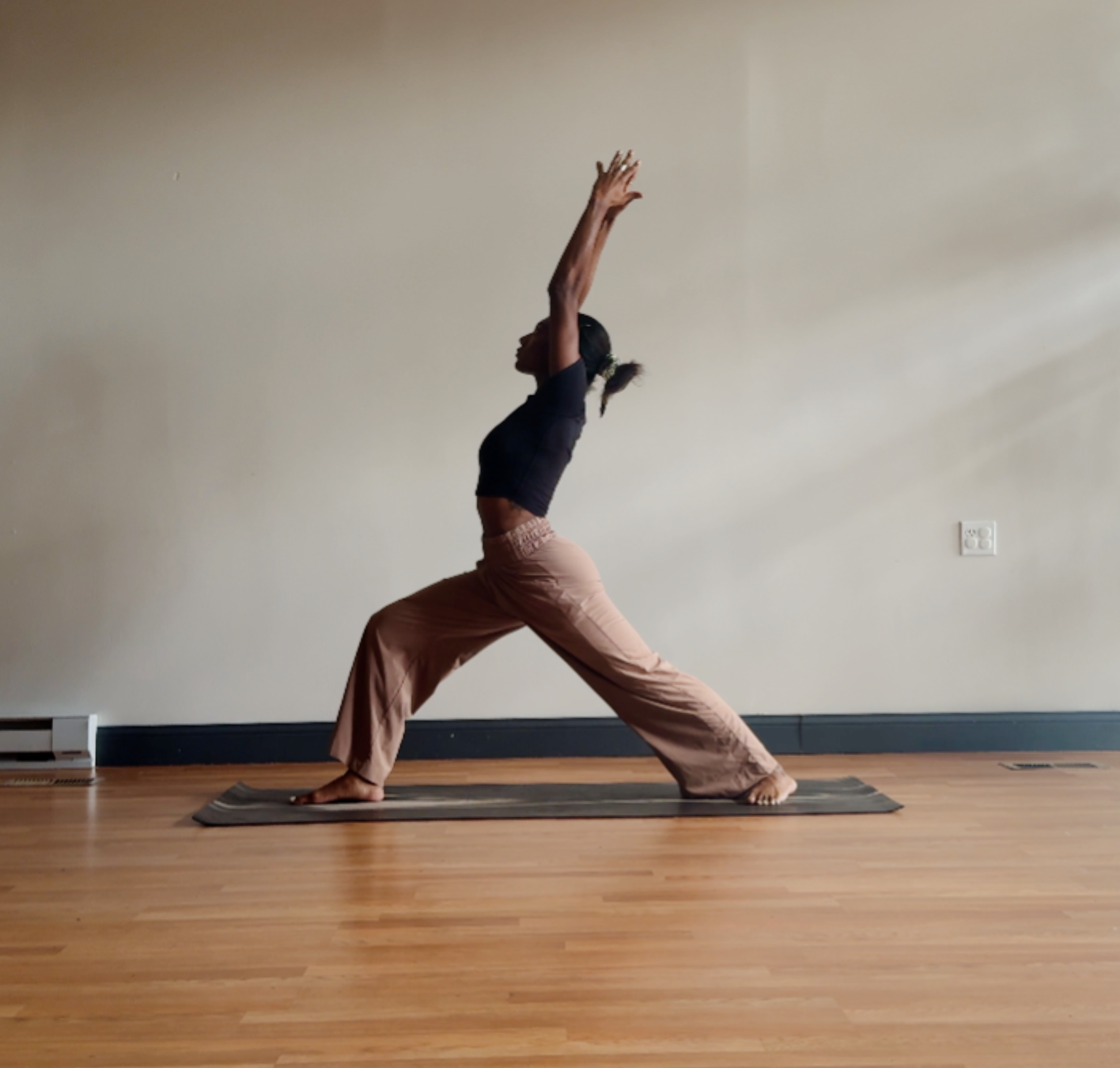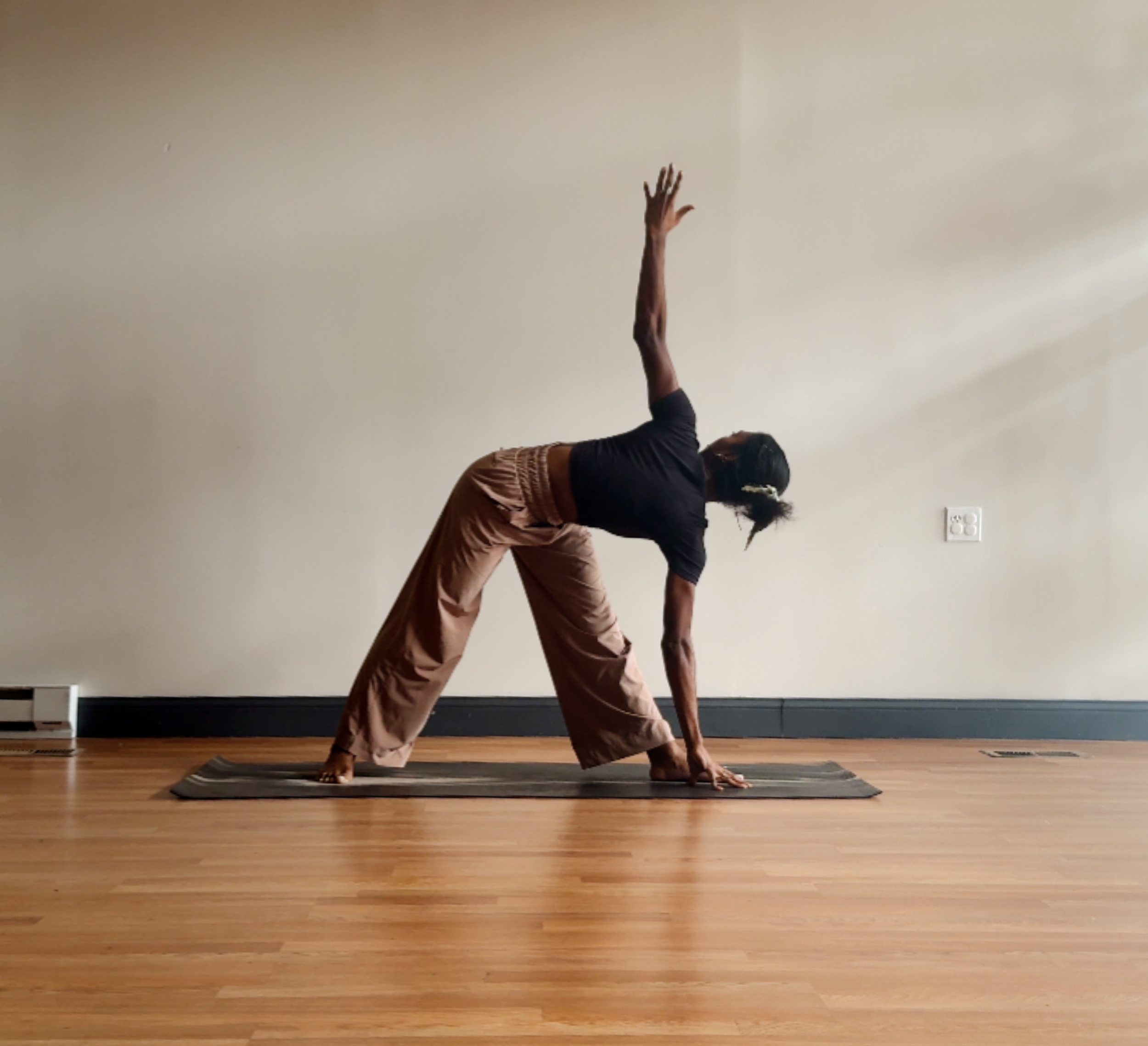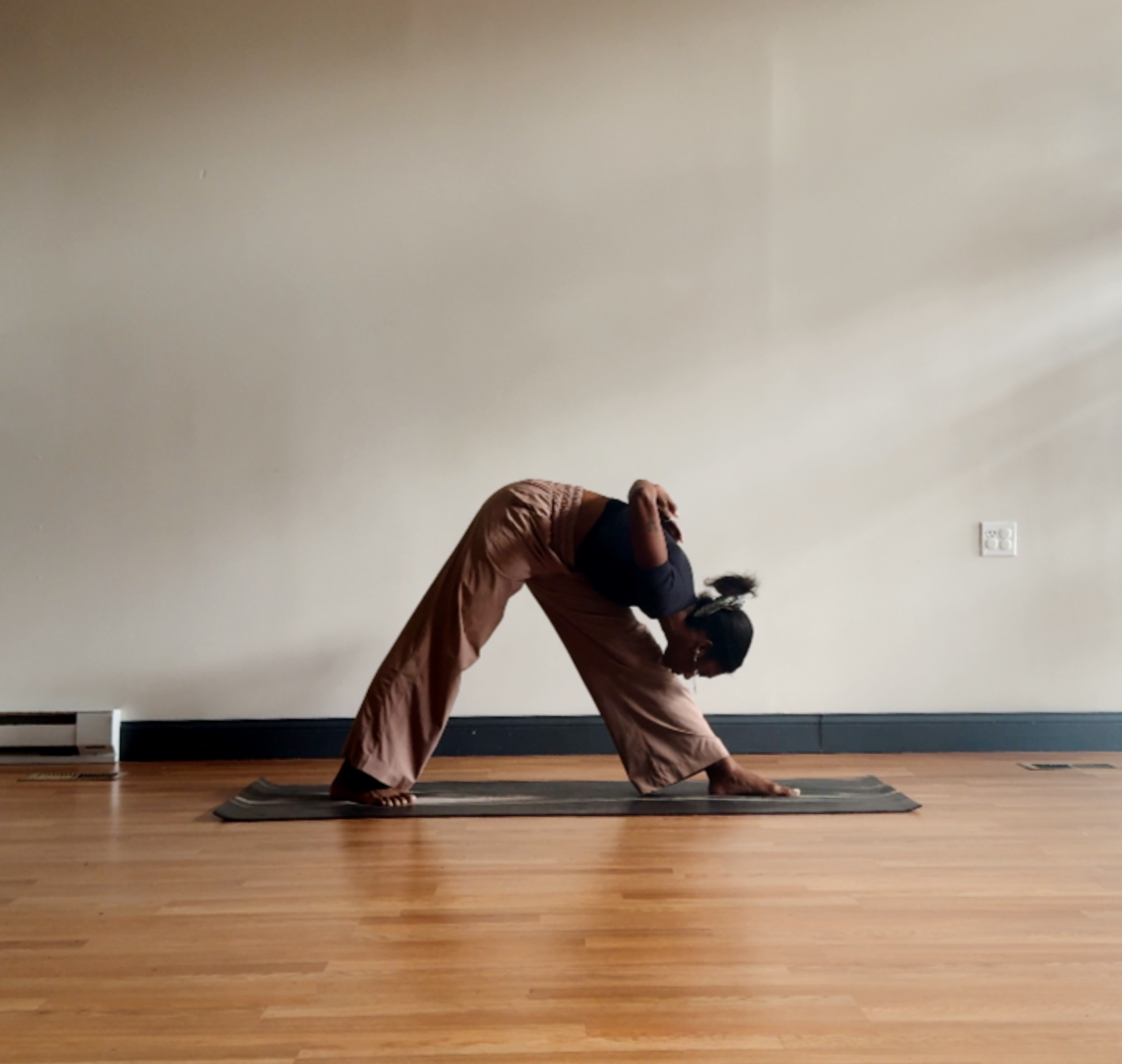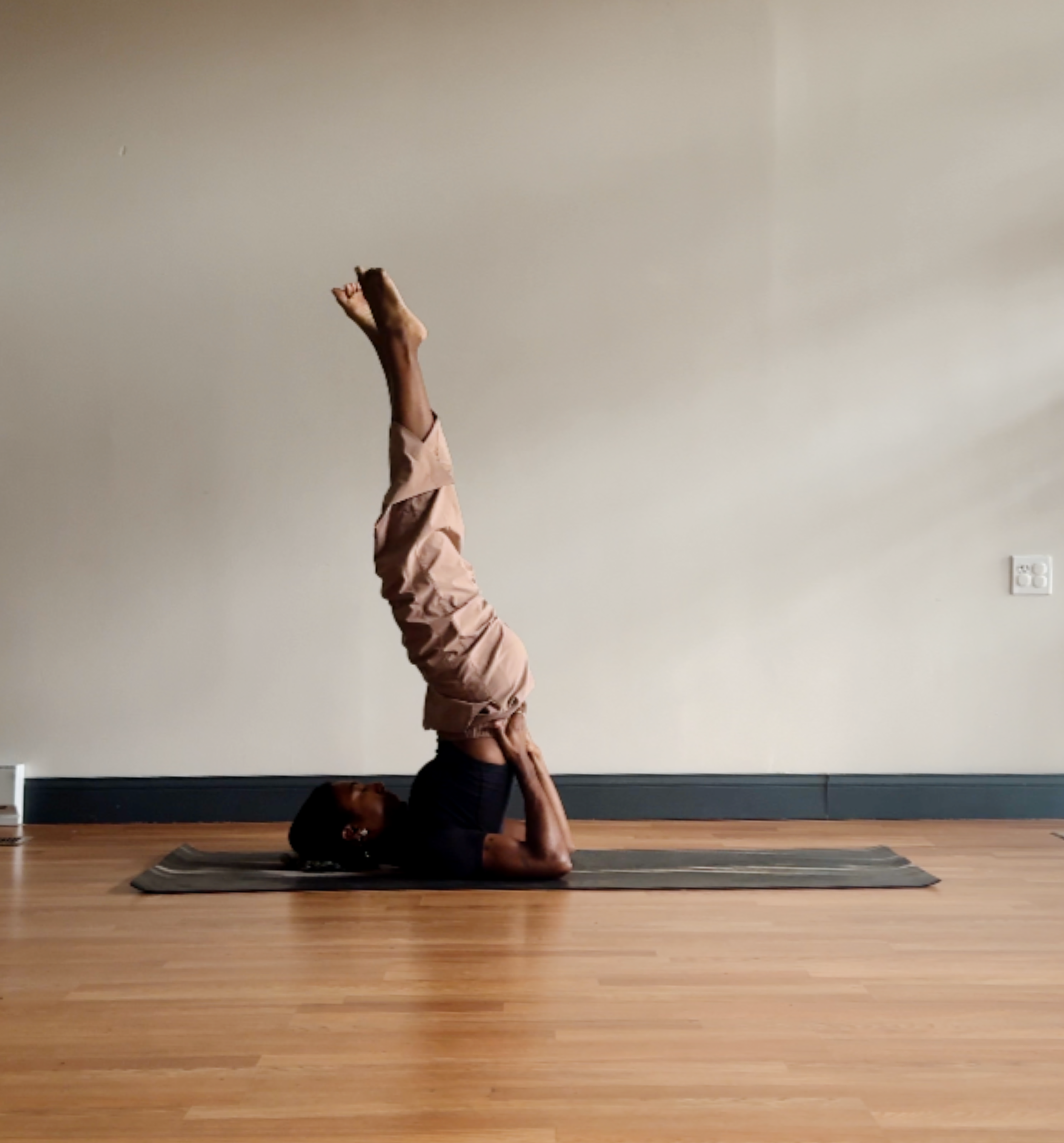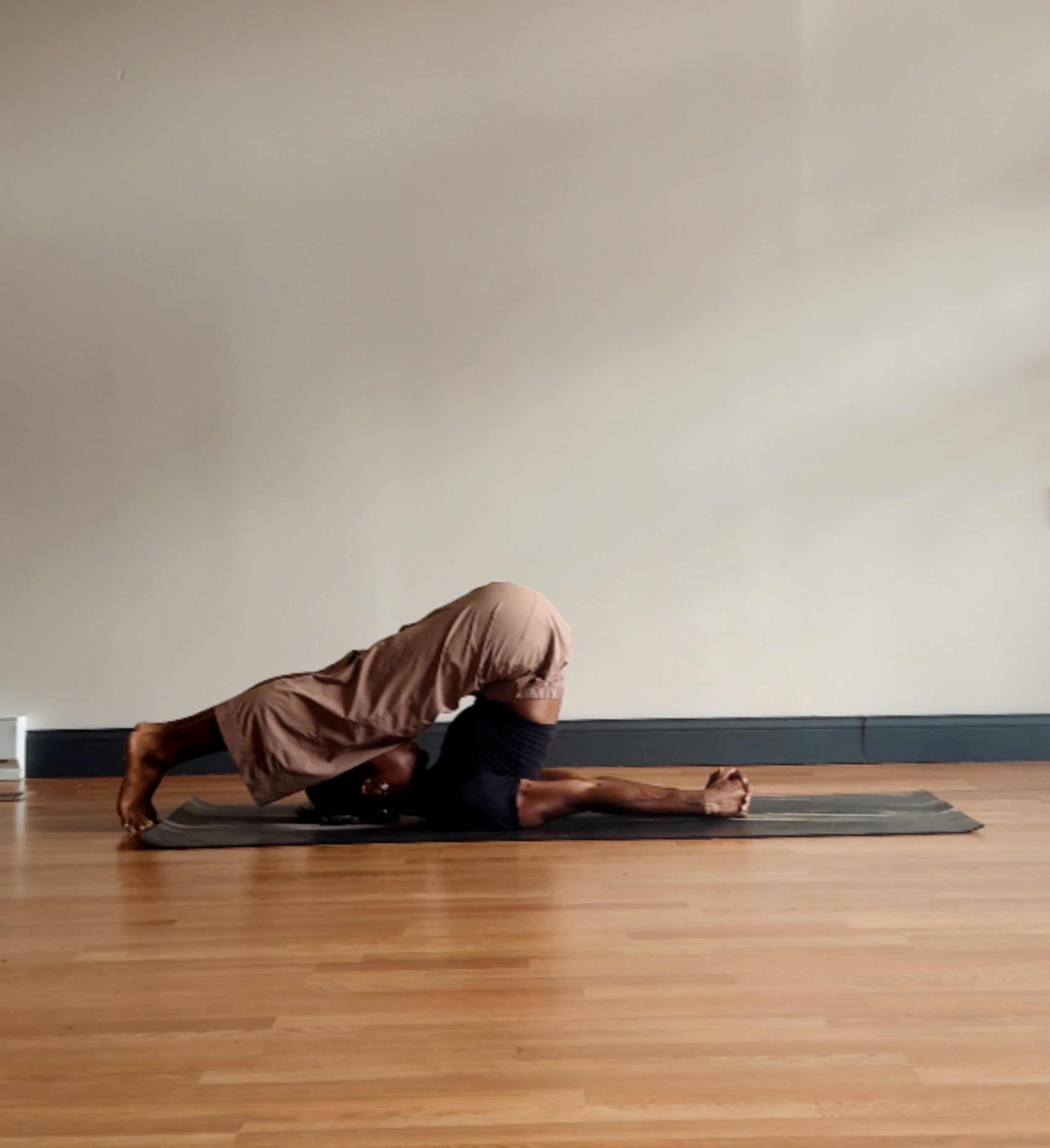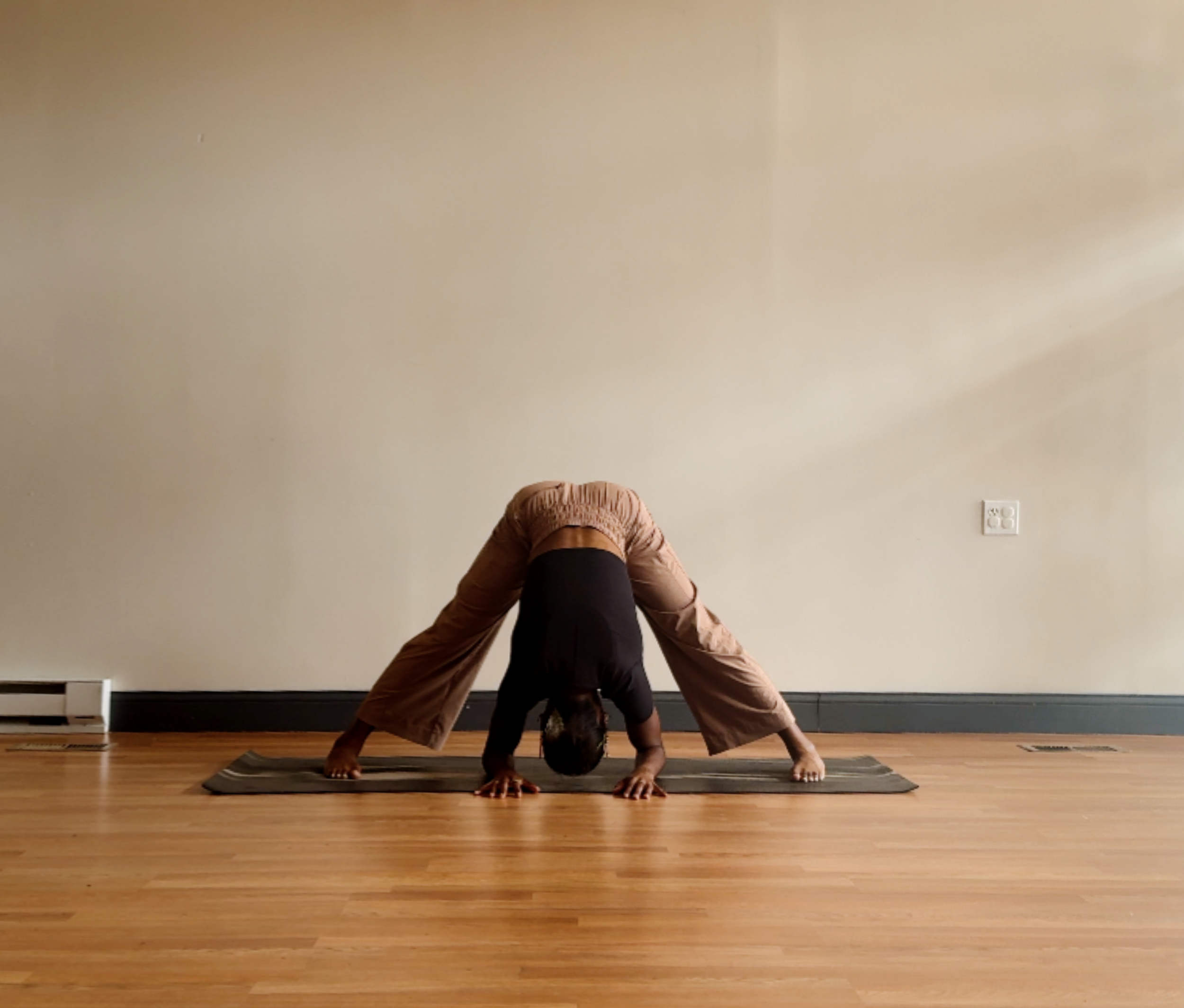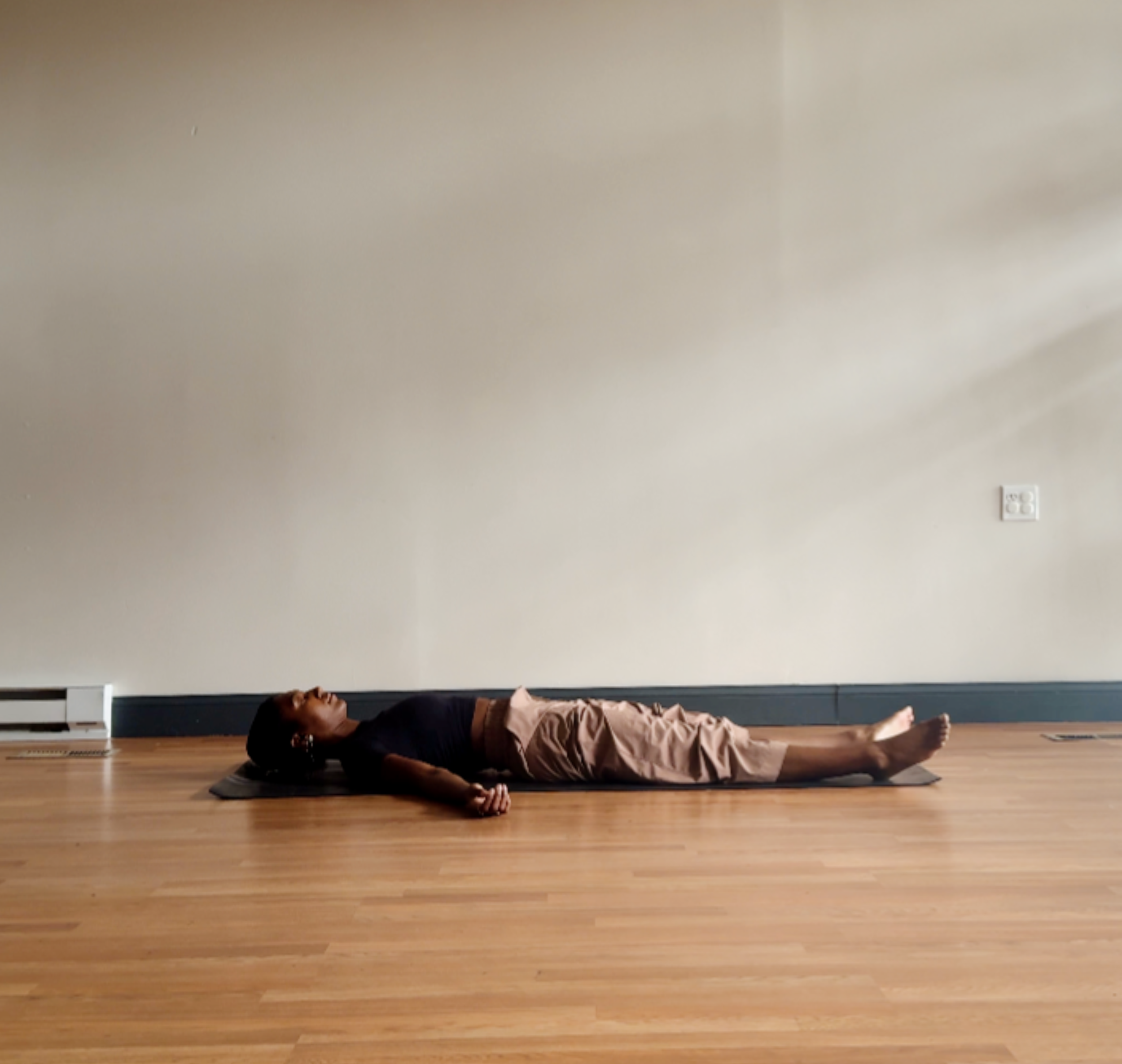IN THIS LESSON
We will continue through our primary series adding on slightly with exploration of twist!
Week 3 & 4 Primary Asanas
Utthita Trikonāsana (Triangle Pose)
-
Start in Straddle
Turn one foot parallel to your mat and the other perpendicular. Engage the quad of the leg with the foot perpendicular to the mat by raising the knee.
Raise arms sideways parallel to the floor.
Bend at the hips bringing front arm near front ankle
Open the chest.
Reach towards the sky with lifted hand
Stay for 8 - 10 breaths
-
Tones muscles in legs
Removes stiffness in legs
Relieves backaches
Strengthens ankles and chest
Uttihita Pārsvakonāsana (Extended Side Angle)
-
Start in Tadasana and move to a straddle
Turn one foot parallel to your mat and the other perpendicular.
Bend at the knee of the front leg to form a 90 degree angle.
Engage the quad of the leg with the foot perpendicular to the mat by raising the knee.
Place front arm to the ground and stretch opposite arm overhead hugging bicep to ear
Stretch top arm further out while opening the chest, engaging the hamstrings of the bent leg, and stretching the spine.
Remain for 5 - 8 breaths
-
Every part of the body is engaged in our extended side angle.
Tone ankles and thighs
Engages the core to strengthen and tone abs
Relieves sciatic and arthritic pain in hips
Aids in elimination increasing peristaltic activity
Virabhadrāsana 2 (Warrior 2)
-
Stand in Tadasana then straddle
Raise both hands above head
Turn one foot parallel to your mat and the other perpendicular.
Bend at the knee of the front leg to form a 90 degree angle.knee.
Stretch hands sideways as though you are being pulled from opposite ends
Turn head to gaze at front hand
Stay for 5 breaths
-
Tones muscles in legs
Brings elasticity to legs and back muscles
Tones Core
Mastering standing postures aids in advanced forward bending postures later
Virabhadrāsana 1 (Warrior 1)
-
Stand in Tadasana then straddle
Raise both hands above head
Turn one foot parallel to your mat and the other perpendicular.
Bend at the knee of the front leg to form a 90 degree angle.
Turn face, chest and hips forward
Lift the gaze towards your hands
Stretch the spine upwards
Stay for 5 breaths
-
Dedicated to the fierce warrior Virabhadra who led Siva's Army
The expansion of the chest allows for deep breathing
Relieves stiff shoulder and back
Tones ankles
Reduces fat around hips
Parivrtta Trikonāsana (Revolved Triangle)
-
Stand in Tadasana then straddle
Turn one foot parallel to your mat and the other perpendicular.
Exhale and rotate torso to face the front leg bringing opposite hand to the front foot
Stretch lifted arm upright keeping arms in line with shoulders
Press all four corners of both feet to the ground
Contract the shoulders to find openness in chest
Stay for 5 breaths
-
Tones thighs, calf and hamstrings
Increases blood flow along lower spinal area (lumbar and sacral)
Strengthens the Hips
Pārsvottānāsana (Pyramid Pose)
-
Start in Tadasana
Step one foot back and turn foot slightly away from midline of mat/body
Join palms behind the back or grab opposite elbows
Turn torso in line with front leg and lift head
Exhale folding forward and rest forehead on knee, progressing until chin can rest
Engage both quads by drawing knee up
Stay for 5 - 8 breaths
-
Relieves stiffness in legs and hips
Aids in elasticity of hips and spine
While folded, the abs are contracted and tones
With shoulders drawn back, this pose can help correct drooping shoulders
Sālamba Sarvāngāsana 1 (Shoulder Stand)
-
Start in Corpse Pose with hands to your side
Move knees to stomach until you reach compression
Raise Hips from floor with exhalale and rest hands on hips, bending arms at the elbows
Lift hips and glutes resting weight on the back of the head, shoulders, and elbows perpendicular.
If you cannot lift the glutes
Place blanket under shoulders and practice bridge pose
Place feet on wall with blanket under shoulders and walk feet further up. When hips lift, bring hands to the back with elbows firmly on the ground
Another option is to find a bench to rest tops of hips on to and place hands under bench for stability
Stay for 30 seconds - 5 mins or 5 - 25 breaths
This is a highly sensitive posture as pressure emerges on our neck. We want to use the pressure in our palsm to raise the trunk and legs up vertically towards the sky.
The breast bone will press the chin to form a chinlock or Jalandhara Bandha. Bring the chest to the chin.
Remember this is an active posture, tighten the back of the thigh muscles and pull legs up.
Elbows should not be pulled wider than shoulders.
Never move the head from side to side in this posture.
-
According to Iyengar, The Shoulder Stand is the Mother of all Asanas. It strives to create harmony and happiness in the human system.
Aids in function of thyroid and parathyroid glands in the back of neck by increasing blood flow here
Once a pupil is able to find ease in this posture it can help with hypertension, shortness of temper, nervous breakdowns
Halāsana (Plow Pose)
-
Complete Shoulder Stand
Release chinlock and lower glutes slightly moving arms and legs overhead
Touch toes to floor
Advance your posture by move arms opposite of legs and interlocking fingers laying palms flat to the ground
-
Similar to the effects of Shoulder Stand
Abs are rejuvenated due to contraction
Helps relieve back aches
Can relieve stiffness in shoulders
One may practice plow pose before shoulder stand if shoulder stand is inaccessible
Prasārita Pādōttānāsana (Straddle Forward Fold)
-
Start in Tadasana
Place hands on hips and step feet 4 - 5 feet apart
Tighten quads by drawing knees upwards
Place hands on the floor
Inhale to lift gaze and keep back flat
Exhale hinge forward until crown of head is pointing towards the ground
All weight remains in the legs
Stay for 5 - 8 breaths
-
Develops Hamstrings and muscles of the abductors
Increases digestion
Allows for revitalization and energy
Helps change perspective
Savāsana (Corpse Pose)
-
Lie on your back
Keep hands in a space of comfort taking up as much room as necessary
Close the eyes, place a cloth over them if possible
Start with deep even breaths and concentrate on fine exhales through the nose
Release tension in the jaw
If the mind wanders pause after each slow exhale to bring it back to the breath
Remain for up to 20 minutes
-
Conscious relaxation invigorates and refreshes the body and mind
Induces calmness of the mind
The stresses of society cause strain on the nerves and savasana is the best antidote




